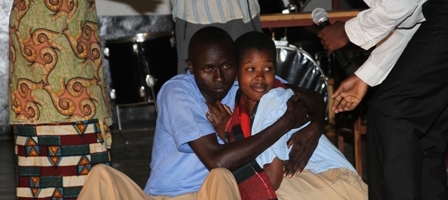'Schools for Dialogue' in Rwanda goes all out for World Peace Day

World Peace Day is being celebrated by young people all over Rwanda who participate in the Schools for Dialogue Project, that is part of the Institute of Research and Dialogue for Peace (IRDP) initiative to help their society overcome the obstacles to lasting peace. Theatre, creative writing, drawing and cartoon strips are all examples of how creative arts and culture can serve as a tool in the peacebuilding process.
Creative arts and culture provide a focus for the activities
The Schools for Dialogue initiative started back in 2007 as follow up to one of the recommendations that had come out of a nationwide consultation on the obstacles to lasting peace. The call was to include young people in the discussion on issues of democracy, tolerance and the functioning of state bodies – all issues that were being discussed during the adult centric forums across the country.
Working with the leaders of tomorrow
Seen by the participants in the overall IRDP process as the leaders of tomorrow, it was felt that their awareness should be raised around issues of tolerance and democratic principles, to engage them in the search for solutions to peacebuilding challenges and to develop their skills in open and critical dialogue. Representing more than half the population - 57% of the population are under 18 – young people are a component of the society born after the genocide. Therefore they are less directly affected by Rwanda’s violent and dictatorial past and by the ethnic divide. However in the minds of other young people – such as children of survivors and children of prisoners – legacies live on as they have been deeply affected by the past of their parents. By involving these young people in a healing, dialoging and creative process the cycle of resentment and social division could be reduced and the foundations of lasting peace laid for the future.
From dialogue to creative expression
Three years on the initiative includes 1,500 students in 25 participating schools. With between 3 to 6 schools in each province, senior level students are introduced to peacebuilding topics and encouraged to openly analyze and debate the issues. But quickly the working methods took on a new dimension.
Both the facilitators, teachers from other schools and the students wanted to double check that the “difficult to address” issues had been grasped by the students. What better way than introducing creativity into the exercise? Participating students were encouraged to ‘think out of the box’ and develop theatre sketches, paintings, poems, cartoons and dances to communicate the issue and their points of view.
A national initiative
2007 remained small scale with the creative pieces being shared within the schools. The following year the project was expanded to become a National Competition. Each school picked a winner in each of the five categories: song; dance; theatre; drawing; or a poem. These winners were then able to compete against students from other schools on the provincial level. The final was held in the capital Kigali, bringing young people together from across the country.
World Peace Day 2010
“For World Peace Day 2010 the schools have been financially supported by the School for Dialogue Project of the Institute of Research and Dialogue for Peace (IRDP), Interpeace’s partner organization in Rwanda, in order to plan various projects in commemoration of that special day.” says Peace Uwineza, IRDP’s Project leader.
“Each school has come up with an independent project to help build sustainable peace in their neighborhood. Rebuilding the social fabric of their community is a priority for many. One group of students has decided to help build a house for a family in need. Others use the money to visit the villages of genocide survivors to talk to witnesses and understand even more,” explains Peace.
As a finale to day – whole schools will be coming together to celebrate the day with food and a special performance of the School for Dialogue Class.
The results of this initiative are building momentum
While funding allows only 25 schools to participate at this stage, requests to become a participating school are constant. Children involved in the initiative are seen to be more tolerant and inclusive. Creative arts are being used to increase understanding of issues, break down barriers including the gap between generations. Students are now getting involved in the adult centric activities and the first University initiative is now in place.
